Business Strategy: Telecommunication Sector (UK)
VerifiedAdded on 2020/12/29
|15
|4795
|50
Report
AI Summary
This report examines the business strategy of O2, a leading telecommunications company in the UK. It analyzes the external environment using PESTLE analysis, evaluates internal resources with the VRIN framework, and assesses competitive intensity using Porter's Five Forces. The report also includes a strategic management plan for O2, outlining key elements for success in the telecommunications sector, and utilizes Bowman's Strategy Clock to determine strategic positioning.
Contribute Materials
Your contribution can guide someone’s learning journey. Share your
documents today.
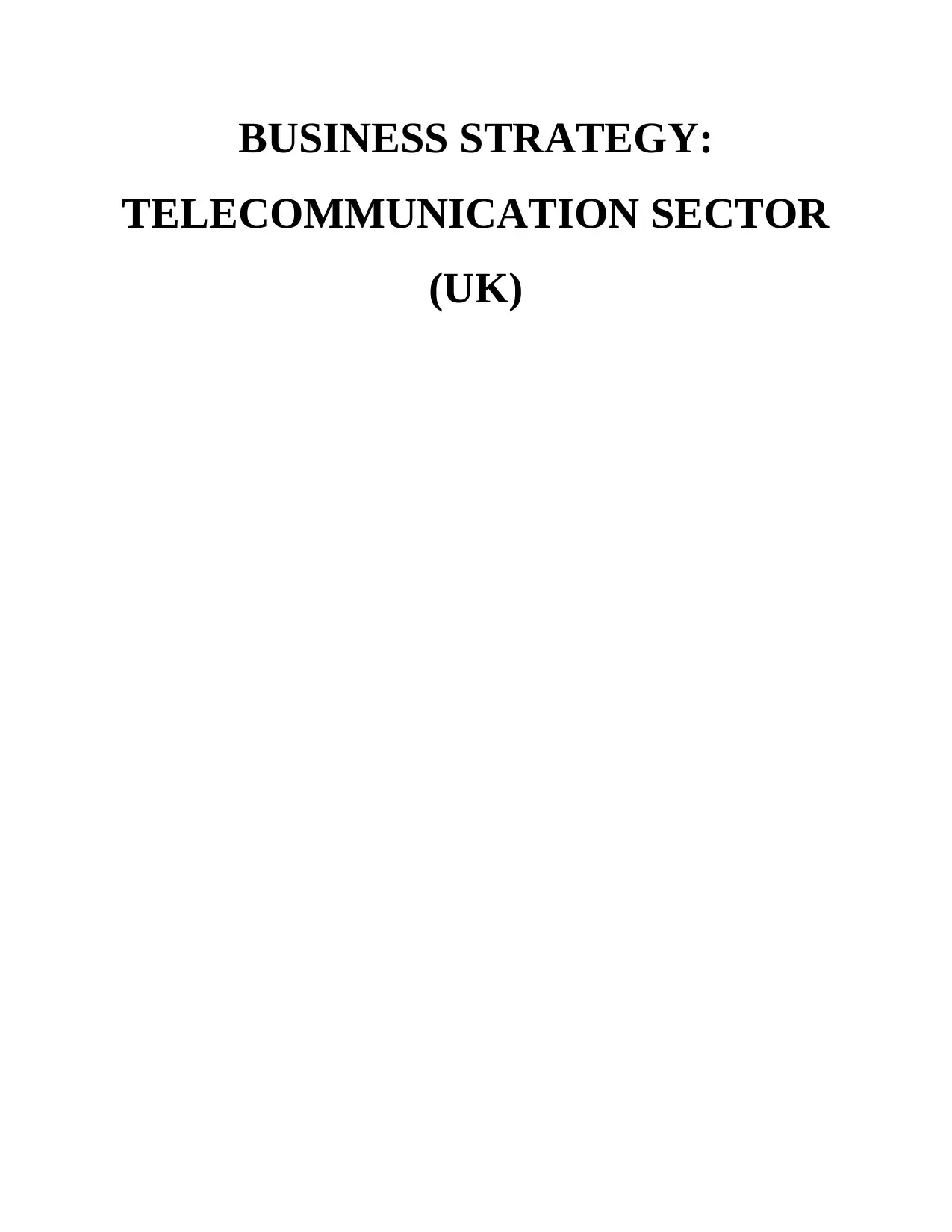
BUSINESS STRATEGY:
TELECOMMUNICATION SECTOR
(UK)
TELECOMMUNICATION SECTOR
(UK)
Secure Best Marks with AI Grader
Need help grading? Try our AI Grader for instant feedback on your assignments.
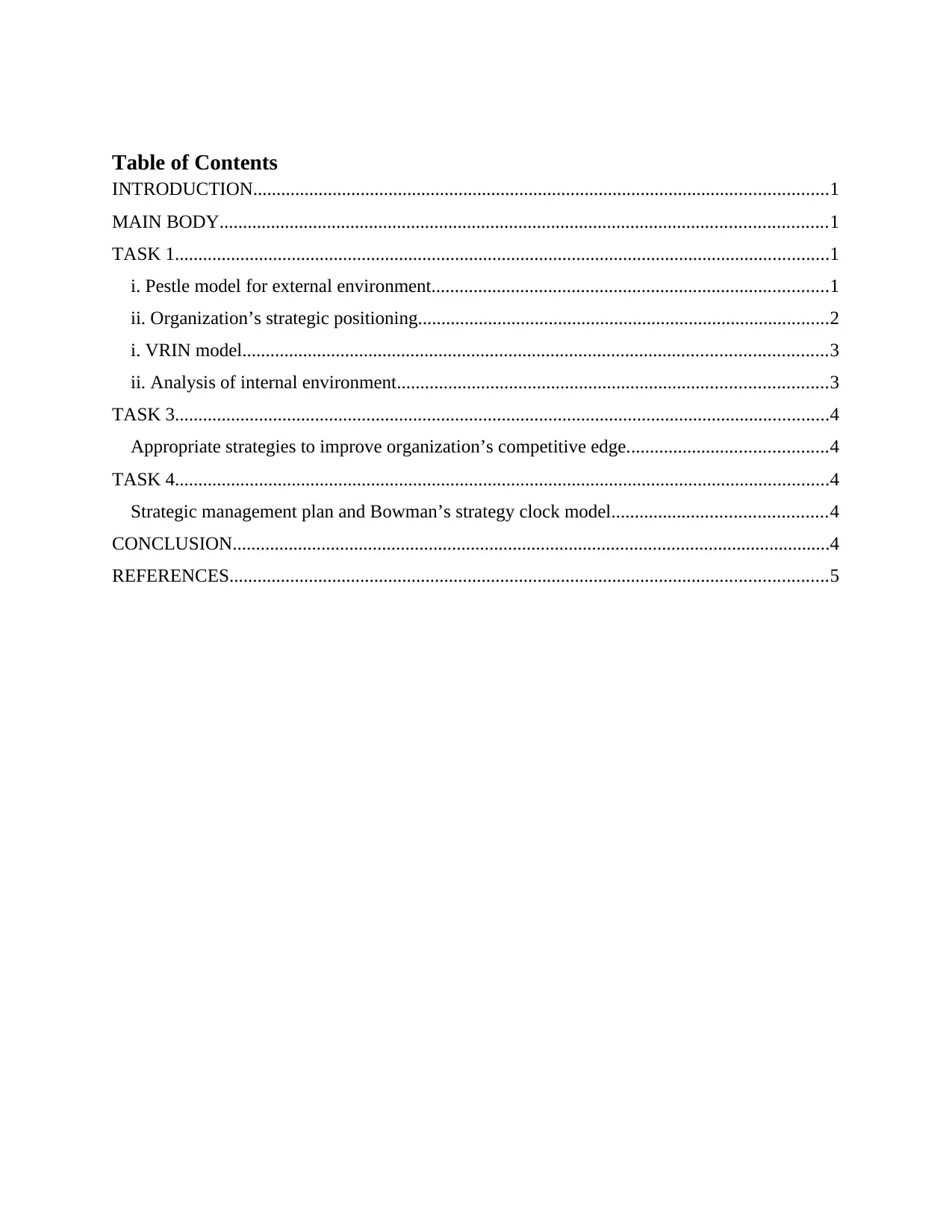
Table of Contents
INTRODUCTION...........................................................................................................................1
MAIN BODY..................................................................................................................................1
TASK 1............................................................................................................................................1
i. Pestle model for external environment.....................................................................................1
ii. Organization’s strategic positioning........................................................................................2
i. VRIN model.............................................................................................................................3
ii. Analysis of internal environment............................................................................................3
TASK 3............................................................................................................................................4
Appropriate strategies to improve organization’s competitive edge...........................................4
TASK 4............................................................................................................................................4
Strategic management plan and Bowman’s strategy clock model..............................................4
CONCLUSION................................................................................................................................4
REFERENCES................................................................................................................................5
INTRODUCTION...........................................................................................................................1
MAIN BODY..................................................................................................................................1
TASK 1............................................................................................................................................1
i. Pestle model for external environment.....................................................................................1
ii. Organization’s strategic positioning........................................................................................2
i. VRIN model.............................................................................................................................3
ii. Analysis of internal environment............................................................................................3
TASK 3............................................................................................................................................4
Appropriate strategies to improve organization’s competitive edge...........................................4
TASK 4............................................................................................................................................4
Strategic management plan and Bowman’s strategy clock model..............................................4
CONCLUSION................................................................................................................................4
REFERENCES................................................................................................................................5
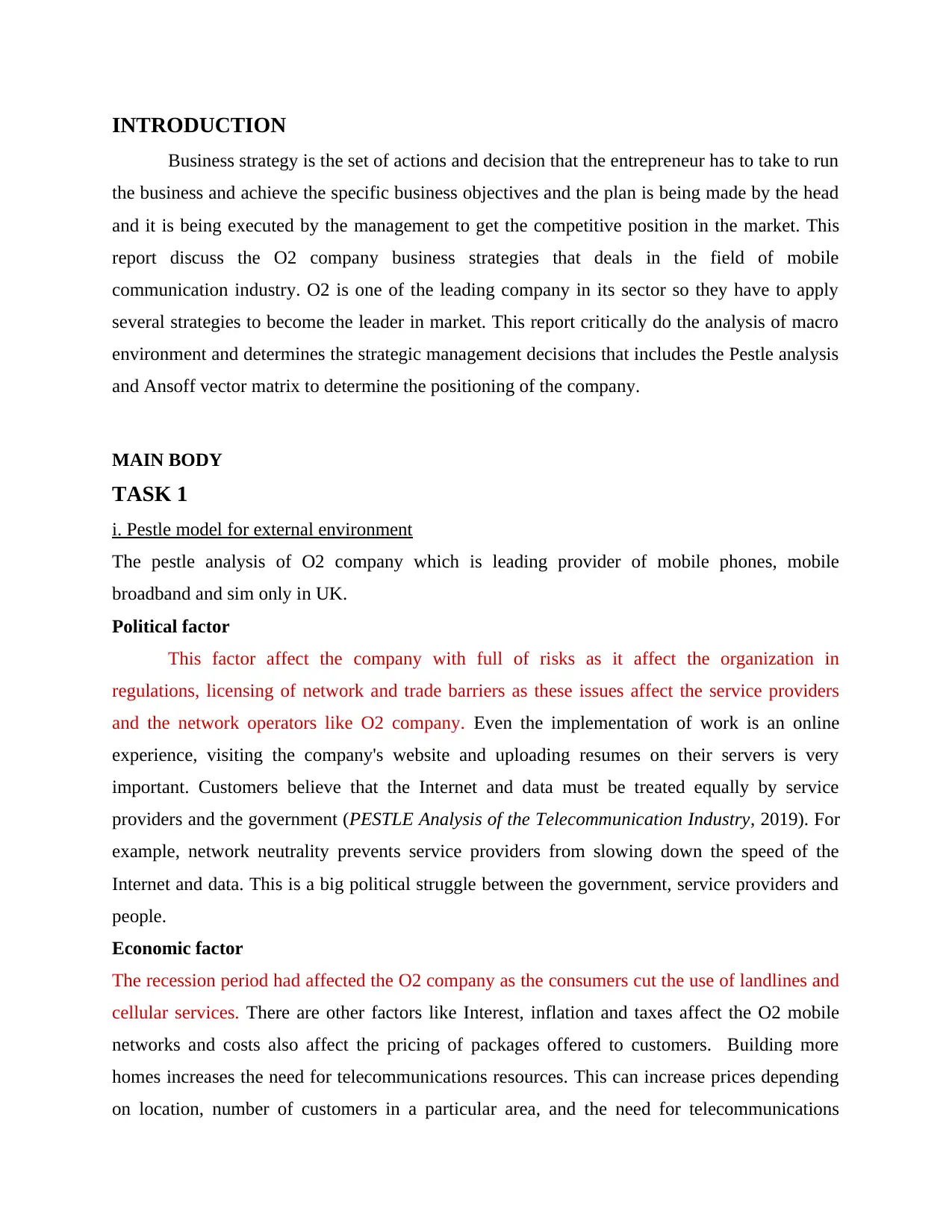
INTRODUCTION
Business strategy is the set of actions and decision that the entrepreneur has to take to run
the business and achieve the specific business objectives and the plan is being made by the head
and it is being executed by the management to get the competitive position in the market. This
report discuss the O2 company business strategies that deals in the field of mobile
communication industry. O2 is one of the leading company in its sector so they have to apply
several strategies to become the leader in market. This report critically do the analysis of macro
environment and determines the strategic management decisions that includes the Pestle analysis
and Ansoff vector matrix to determine the positioning of the company.
MAIN BODY
TASK 1
i. Pestle model for external environment
The pestle analysis of O2 company which is leading provider of mobile phones, mobile
broadband and sim only in UK.
Political factor
This factor affect the company with full of risks as it affect the organization in
regulations, licensing of network and trade barriers as these issues affect the service providers
and the network operators like O2 company. Even the implementation of work is an online
experience, visiting the company's website and uploading resumes on their servers is very
important. Customers believe that the Internet and data must be treated equally by service
providers and the government (PESTLE Analysis of the Telecommunication Industry, 2019). For
example, network neutrality prevents service providers from slowing down the speed of the
Internet and data. This is a big political struggle between the government, service providers and
people.
Economic factor
The recession period had affected the O2 company as the consumers cut the use of landlines and
cellular services. There are other factors like Interest, inflation and taxes affect the O2 mobile
networks and costs also affect the pricing of packages offered to customers. Building more
homes increases the need for telecommunications resources. This can increase prices depending
on location, number of customers in a particular area, and the need for telecommunications
Business strategy is the set of actions and decision that the entrepreneur has to take to run
the business and achieve the specific business objectives and the plan is being made by the head
and it is being executed by the management to get the competitive position in the market. This
report discuss the O2 company business strategies that deals in the field of mobile
communication industry. O2 is one of the leading company in its sector so they have to apply
several strategies to become the leader in market. This report critically do the analysis of macro
environment and determines the strategic management decisions that includes the Pestle analysis
and Ansoff vector matrix to determine the positioning of the company.
MAIN BODY
TASK 1
i. Pestle model for external environment
The pestle analysis of O2 company which is leading provider of mobile phones, mobile
broadband and sim only in UK.
Political factor
This factor affect the company with full of risks as it affect the organization in
regulations, licensing of network and trade barriers as these issues affect the service providers
and the network operators like O2 company. Even the implementation of work is an online
experience, visiting the company's website and uploading resumes on their servers is very
important. Customers believe that the Internet and data must be treated equally by service
providers and the government (PESTLE Analysis of the Telecommunication Industry, 2019). For
example, network neutrality prevents service providers from slowing down the speed of the
Internet and data. This is a big political struggle between the government, service providers and
people.
Economic factor
The recession period had affected the O2 company as the consumers cut the use of landlines and
cellular services. There are other factors like Interest, inflation and taxes affect the O2 mobile
networks and costs also affect the pricing of packages offered to customers. Building more
homes increases the need for telecommunications resources. This can increase prices depending
on location, number of customers in a particular area, and the need for telecommunications

services. Growth depends on the market and technological progress. O2 company uses the
Internet and cell phones for marketing. They create social media pages, website ads, and digital
marketing campaigns to reach customers all over the world
Social factors: Horizontal growth of O2 mobile network is limited. In particular, it is difficult to
develop into rural areas. Customers still have fewer opportunities to buy Internet, cellular and
TV packages. O2 company is a monopoly, they are responsible for the Internet and cellular
operators. Customers need this package to communicate with friends, participate in social media
challenges, buy products online, find stable careers, and more. Telecommunications has become
a very important aspect of everyday life.
Technological factors: Both the need and demand for telecommunications services are
increasing. For example, O2 mobile network company are now installing fiber in their copper
designs. Phones are becoming increasingly crowded, turning the telecommunications business
into a largely wireless business. Basic smartphone needs included, such as voicemail, caller ID
and messaging. People now want access to the Internet while travelling. So, data is added to the
cellular package and Wi-Fi is also built in buses and cars.
Legal factors: O2 company is often influenced by legal problems and the problem with the
government, monopolies, and customers. But the company has allowed the import and export of
telecommunications products. Innovations in information and communication technology (ICT)
and increasing demand have had a serious impact on public telecommunications and ICT
infrastructure, including the trend towards deregulation and liberalization of the
telecommunications market.
Environmental factor: Climate change and global warming can influence the O2 company
products to reach customers. In terms of work, company need to adapt to change as technology
advances.
Analysis of having the impact and influence of macro environment in O2
As the macro environment is being analysed in the first step of strategic analysis as it kicks off
the tradition, strategic planning cycle as it is sometimes being referred as an external analysis. As
the macro environment identify the possible opportunities and the threats that impact the industry
as a whole and that is being the outside in the control of the industry. Reduction in the disposable
income may affect the industry.
Internet and cell phones for marketing. They create social media pages, website ads, and digital
marketing campaigns to reach customers all over the world
Social factors: Horizontal growth of O2 mobile network is limited. In particular, it is difficult to
develop into rural areas. Customers still have fewer opportunities to buy Internet, cellular and
TV packages. O2 company is a monopoly, they are responsible for the Internet and cellular
operators. Customers need this package to communicate with friends, participate in social media
challenges, buy products online, find stable careers, and more. Telecommunications has become
a very important aspect of everyday life.
Technological factors: Both the need and demand for telecommunications services are
increasing. For example, O2 mobile network company are now installing fiber in their copper
designs. Phones are becoming increasingly crowded, turning the telecommunications business
into a largely wireless business. Basic smartphone needs included, such as voicemail, caller ID
and messaging. People now want access to the Internet while travelling. So, data is added to the
cellular package and Wi-Fi is also built in buses and cars.
Legal factors: O2 company is often influenced by legal problems and the problem with the
government, monopolies, and customers. But the company has allowed the import and export of
telecommunications products. Innovations in information and communication technology (ICT)
and increasing demand have had a serious impact on public telecommunications and ICT
infrastructure, including the trend towards deregulation and liberalization of the
telecommunications market.
Environmental factor: Climate change and global warming can influence the O2 company
products to reach customers. In terms of work, company need to adapt to change as technology
advances.
Analysis of having the impact and influence of macro environment in O2
As the macro environment is being analysed in the first step of strategic analysis as it kicks off
the tradition, strategic planning cycle as it is sometimes being referred as an external analysis. As
the macro environment identify the possible opportunities and the threats that impact the industry
as a whole and that is being the outside in the control of the industry. Reduction in the disposable
income may affect the industry.
Secure Best Marks with AI Grader
Need help grading? Try our AI Grader for instant feedback on your assignments.
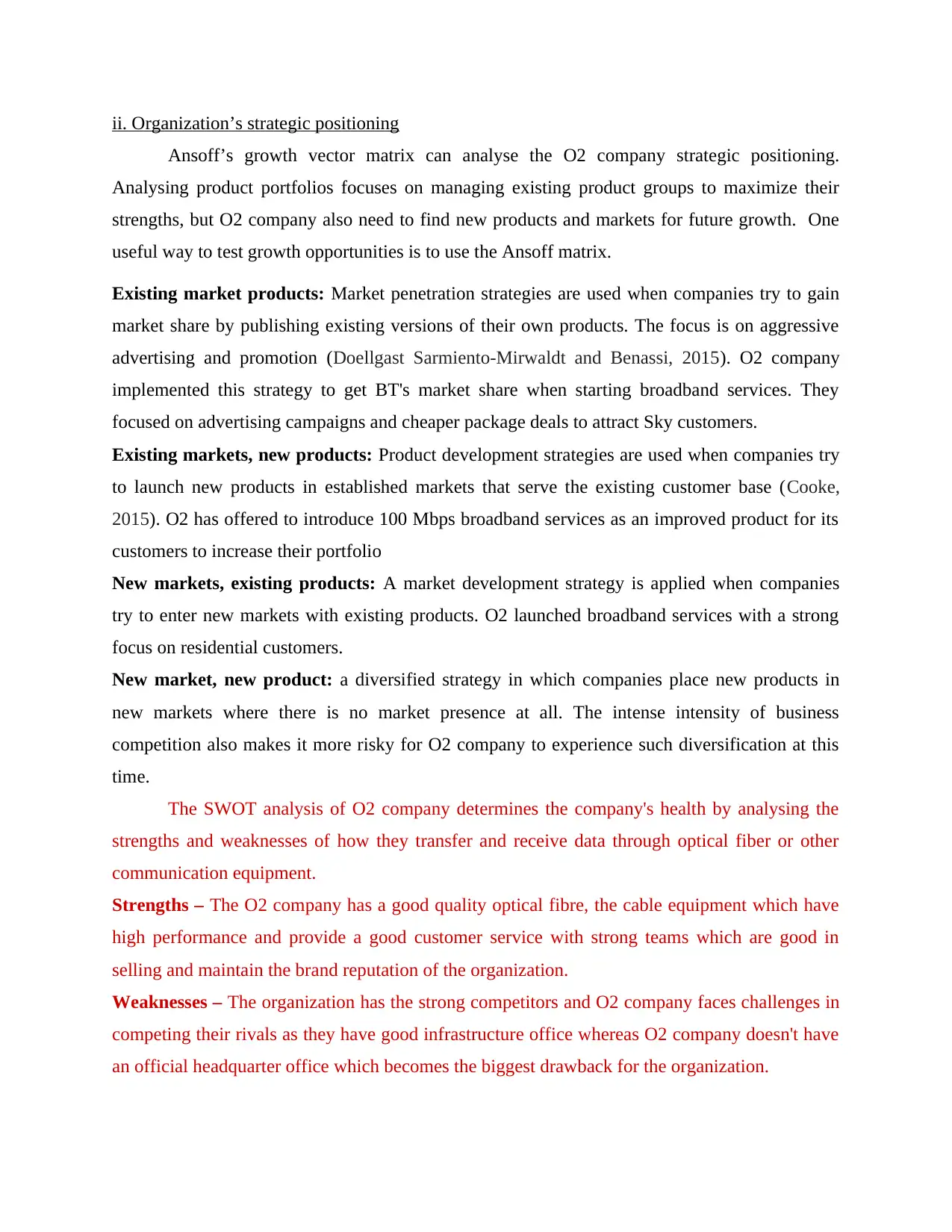
ii. Organization’s strategic positioning
Ansoff’s growth vector matrix can analyse the O2 company strategic positioning.
Analysing product portfolios focuses on managing existing product groups to maximize their
strengths, but O2 company also need to find new products and markets for future growth. One
useful way to test growth opportunities is to use the Ansoff matrix.
Existing market products: Market penetration strategies are used when companies try to gain
market share by publishing existing versions of their own products. The focus is on aggressive
advertising and promotion (Doellgast Sarmiento-Mirwaldt and Benassi, 2015). O2 company
implemented this strategy to get BT's market share when starting broadband services. They
focused on advertising campaigns and cheaper package deals to attract Sky customers.
Existing markets, new products: Product development strategies are used when companies try
to launch new products in established markets that serve the existing customer base (Cooke,
2015). O2 has offered to introduce 100 Mbps broadband services as an improved product for its
customers to increase their portfolio
New markets, existing products: A market development strategy is applied when companies
try to enter new markets with existing products. O2 launched broadband services with a strong
focus on residential customers.
New market, new product: a diversified strategy in which companies place new products in
new markets where there is no market presence at all. The intense intensity of business
competition also makes it more risky for O2 company to experience such diversification at this
time.
The SWOT analysis of O2 company determines the company's health by analysing the
strengths and weaknesses of how they transfer and receive data through optical fiber or other
communication equipment.
Strengths – The O2 company has a good quality optical fibre, the cable equipment which have
high performance and provide a good customer service with strong teams which are good in
selling and maintain the brand reputation of the organization.
Weaknesses – The organization has the strong competitors and O2 company faces challenges in
competing their rivals as they have good infrastructure office whereas O2 company doesn't have
an official headquarter office which becomes the biggest drawback for the organization.
Ansoff’s growth vector matrix can analyse the O2 company strategic positioning.
Analysing product portfolios focuses on managing existing product groups to maximize their
strengths, but O2 company also need to find new products and markets for future growth. One
useful way to test growth opportunities is to use the Ansoff matrix.
Existing market products: Market penetration strategies are used when companies try to gain
market share by publishing existing versions of their own products. The focus is on aggressive
advertising and promotion (Doellgast Sarmiento-Mirwaldt and Benassi, 2015). O2 company
implemented this strategy to get BT's market share when starting broadband services. They
focused on advertising campaigns and cheaper package deals to attract Sky customers.
Existing markets, new products: Product development strategies are used when companies try
to launch new products in established markets that serve the existing customer base (Cooke,
2015). O2 has offered to introduce 100 Mbps broadband services as an improved product for its
customers to increase their portfolio
New markets, existing products: A market development strategy is applied when companies
try to enter new markets with existing products. O2 launched broadband services with a strong
focus on residential customers.
New market, new product: a diversified strategy in which companies place new products in
new markets where there is no market presence at all. The intense intensity of business
competition also makes it more risky for O2 company to experience such diversification at this
time.
The SWOT analysis of O2 company determines the company's health by analysing the
strengths and weaknesses of how they transfer and receive data through optical fiber or other
communication equipment.
Strengths – The O2 company has a good quality optical fibre, the cable equipment which have
high performance and provide a good customer service with strong teams which are good in
selling and maintain the brand reputation of the organization.
Weaknesses – The organization has the strong competitors and O2 company faces challenges in
competing their rivals as they have good infrastructure office whereas O2 company doesn't have
an official headquarter office which becomes the biggest drawback for the organization.
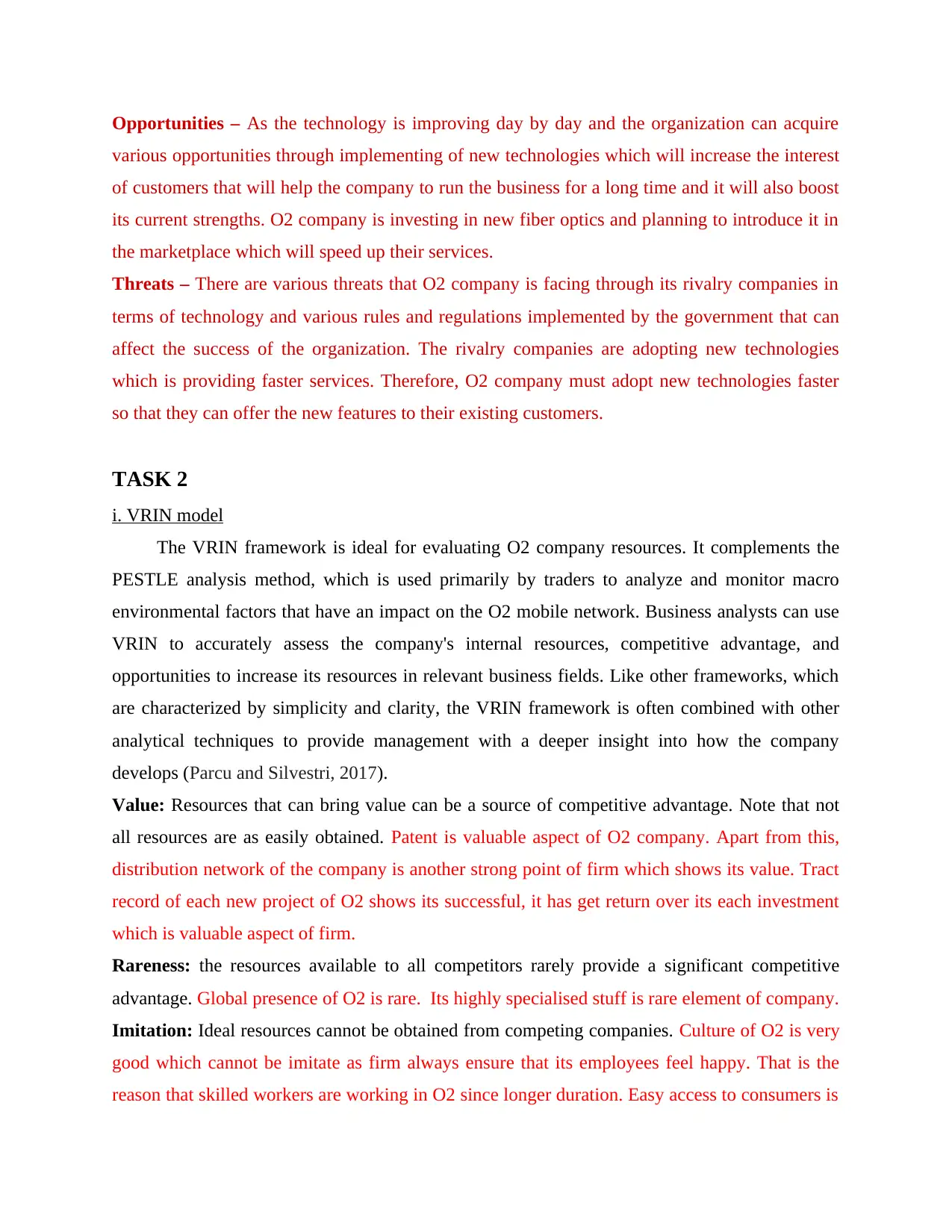
Opportunities – As the technology is improving day by day and the organization can acquire
various opportunities through implementing of new technologies which will increase the interest
of customers that will help the company to run the business for a long time and it will also boost
its current strengths. O2 company is investing in new fiber optics and planning to introduce it in
the marketplace which will speed up their services.
Threats – There are various threats that O2 company is facing through its rivalry companies in
terms of technology and various rules and regulations implemented by the government that can
affect the success of the organization. The rivalry companies are adopting new technologies
which is providing faster services. Therefore, O2 company must adopt new technologies faster
so that they can offer the new features to their existing customers.
TASK 2
i. VRIN model
The VRIN framework is ideal for evaluating O2 company resources. It complements the
PESTLE analysis method, which is used primarily by traders to analyze and monitor macro
environmental factors that have an impact on the O2 mobile network. Business analysts can use
VRIN to accurately assess the company's internal resources, competitive advantage, and
opportunities to increase its resources in relevant business fields. Like other frameworks, which
are characterized by simplicity and clarity, the VRIN framework is often combined with other
analytical techniques to provide management with a deeper insight into how the company
develops (Parcu and Silvestri, 2017).
Value: Resources that can bring value can be a source of competitive advantage. Note that not
all resources are as easily obtained. Patent is valuable aspect of O2 company. Apart from this,
distribution network of the company is another strong point of firm which shows its value. Tract
record of each new project of O2 shows its successful, it has get return over its each investment
which is valuable aspect of firm.
Rareness: the resources available to all competitors rarely provide a significant competitive
advantage. Global presence of O2 is rare. Its highly specialised stuff is rare element of company.
Imitation: Ideal resources cannot be obtained from competing companies. Culture of O2 is very
good which cannot be imitate as firm always ensure that its employees feel happy. That is the
reason that skilled workers are working in O2 since longer duration. Easy access to consumers is
various opportunities through implementing of new technologies which will increase the interest
of customers that will help the company to run the business for a long time and it will also boost
its current strengths. O2 company is investing in new fiber optics and planning to introduce it in
the marketplace which will speed up their services.
Threats – There are various threats that O2 company is facing through its rivalry companies in
terms of technology and various rules and regulations implemented by the government that can
affect the success of the organization. The rivalry companies are adopting new technologies
which is providing faster services. Therefore, O2 company must adopt new technologies faster
so that they can offer the new features to their existing customers.
TASK 2
i. VRIN model
The VRIN framework is ideal for evaluating O2 company resources. It complements the
PESTLE analysis method, which is used primarily by traders to analyze and monitor macro
environmental factors that have an impact on the O2 mobile network. Business analysts can use
VRIN to accurately assess the company's internal resources, competitive advantage, and
opportunities to increase its resources in relevant business fields. Like other frameworks, which
are characterized by simplicity and clarity, the VRIN framework is often combined with other
analytical techniques to provide management with a deeper insight into how the company
develops (Parcu and Silvestri, 2017).
Value: Resources that can bring value can be a source of competitive advantage. Note that not
all resources are as easily obtained. Patent is valuable aspect of O2 company. Apart from this,
distribution network of the company is another strong point of firm which shows its value. Tract
record of each new project of O2 shows its successful, it has get return over its each investment
which is valuable aspect of firm.
Rareness: the resources available to all competitors rarely provide a significant competitive
advantage. Global presence of O2 is rare. Its highly specialised stuff is rare element of company.
Imitation: Ideal resources cannot be obtained from competing companies. Culture of O2 is very
good which cannot be imitate as firm always ensure that its employees feel happy. That is the
reason that skilled workers are working in O2 since longer duration. Easy access to consumers is

another major imitate point that shows that how the firm is segmenting consumers that things
cannot be copied.
Non-substitutable: Ideal resources cannot be replaced by other resources, it organises its
financial resources in systematic manner so that it can get benefit out of it.
ii. Analysis of internal environment
SWOT analysis is the best tool to identify the internal environment of O2 company.
Strengths
The environment of work is good as the most of the work is done online.
O2 company offers excellent goods and services to their customers in all types of
telecommunication.
The company has many awards like Forrester Groundswell Award as Most Innovative
Community at the Social CRM Customer Excellence Awards which increased their
reputation (Gerli Wainwright and Whalley, 2017).
They have strong business operations and promotion strategies and every types of SIMs
are available at their store.
They developed Corporate Social Responsibility for charities such as Teenage Cancer
Trust and Air Ambulance service.
Weaknesses
O2 is small company which does not have actual employee support, call centres and
office
They don’t have money to fund in big advertising campaigns except television
commercials.
O2 company present market has limited operations in the United Kingdom.
They have minimum number of stores to provide services like handsets, contracts and
insurance.
Canceled cables, slow service, and bad sales are three weaknesses that can endanger
telecommunication companies. Business weaknesses are competitive losses that put the
company in an unfavorable position on the market. If damaged cables are not replaced and
slow service continues, for example, dissatisfied customers turn to competitive
telecommunications companies that offer better services.
cannot be copied.
Non-substitutable: Ideal resources cannot be replaced by other resources, it organises its
financial resources in systematic manner so that it can get benefit out of it.
ii. Analysis of internal environment
SWOT analysis is the best tool to identify the internal environment of O2 company.
Strengths
The environment of work is good as the most of the work is done online.
O2 company offers excellent goods and services to their customers in all types of
telecommunication.
The company has many awards like Forrester Groundswell Award as Most Innovative
Community at the Social CRM Customer Excellence Awards which increased their
reputation (Gerli Wainwright and Whalley, 2017).
They have strong business operations and promotion strategies and every types of SIMs
are available at their store.
They developed Corporate Social Responsibility for charities such as Teenage Cancer
Trust and Air Ambulance service.
Weaknesses
O2 is small company which does not have actual employee support, call centres and
office
They don’t have money to fund in big advertising campaigns except television
commercials.
O2 company present market has limited operations in the United Kingdom.
They have minimum number of stores to provide services like handsets, contracts and
insurance.
Canceled cables, slow service, and bad sales are three weaknesses that can endanger
telecommunication companies. Business weaknesses are competitive losses that put the
company in an unfavorable position on the market. If damaged cables are not replaced and
slow service continues, for example, dissatisfied customers turn to competitive
telecommunications companies that offer better services.
Paraphrase This Document
Need a fresh take? Get an instant paraphrase of this document with our AI Paraphraser
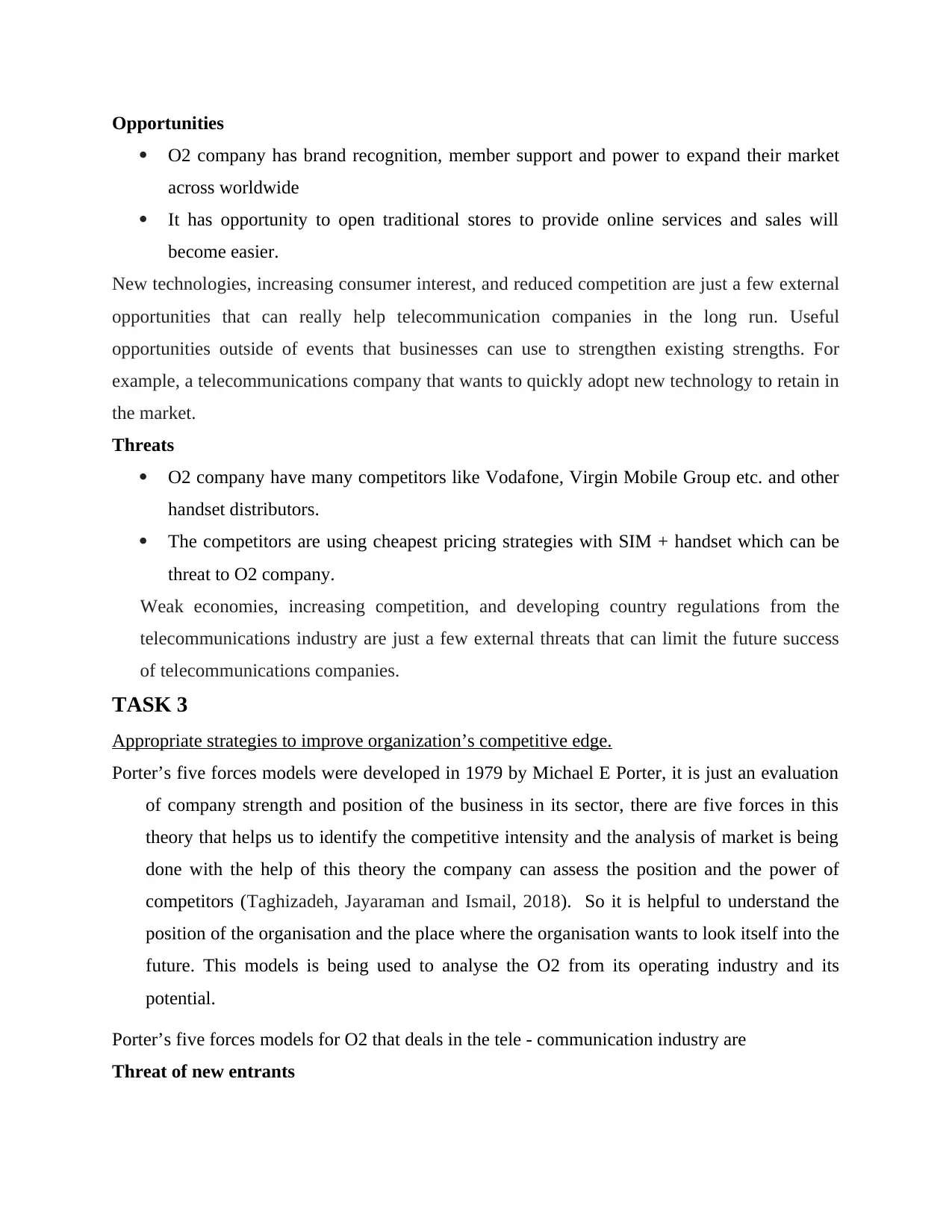
Opportunities
O2 company has brand recognition, member support and power to expand their market
across worldwide
It has opportunity to open traditional stores to provide online services and sales will
become easier.
New technologies, increasing consumer interest, and reduced competition are just a few external
opportunities that can really help telecommunication companies in the long run. Useful
opportunities outside of events that businesses can use to strengthen existing strengths. For
example, a telecommunications company that wants to quickly adopt new technology to retain in
the market.
Threats
O2 company have many competitors like Vodafone, Virgin Mobile Group etc. and other
handset distributors.
The competitors are using cheapest pricing strategies with SIM + handset which can be
threat to O2 company.
Weak economies, increasing competition, and developing country regulations from the
telecommunications industry are just a few external threats that can limit the future success
of telecommunications companies.
TASK 3
Appropriate strategies to improve organization’s competitive edge.
Porter’s five forces models were developed in 1979 by Michael E Porter, it is just an evaluation
of company strength and position of the business in its sector, there are five forces in this
theory that helps us to identify the competitive intensity and the analysis of market is being
done with the help of this theory the company can assess the position and the power of
competitors (Taghizadeh, Jayaraman and Ismail, 2018). So it is helpful to understand the
position of the organisation and the place where the organisation wants to look itself into the
future. This models is being used to analyse the O2 from its operating industry and its
potential.
Porter’s five forces models for O2 that deals in the tele - communication industry are
Threat of new entrants
O2 company has brand recognition, member support and power to expand their market
across worldwide
It has opportunity to open traditional stores to provide online services and sales will
become easier.
New technologies, increasing consumer interest, and reduced competition are just a few external
opportunities that can really help telecommunication companies in the long run. Useful
opportunities outside of events that businesses can use to strengthen existing strengths. For
example, a telecommunications company that wants to quickly adopt new technology to retain in
the market.
Threats
O2 company have many competitors like Vodafone, Virgin Mobile Group etc. and other
handset distributors.
The competitors are using cheapest pricing strategies with SIM + handset which can be
threat to O2 company.
Weak economies, increasing competition, and developing country regulations from the
telecommunications industry are just a few external threats that can limit the future success
of telecommunications companies.
TASK 3
Appropriate strategies to improve organization’s competitive edge.
Porter’s five forces models were developed in 1979 by Michael E Porter, it is just an evaluation
of company strength and position of the business in its sector, there are five forces in this
theory that helps us to identify the competitive intensity and the analysis of market is being
done with the help of this theory the company can assess the position and the power of
competitors (Taghizadeh, Jayaraman and Ismail, 2018). So it is helpful to understand the
position of the organisation and the place where the organisation wants to look itself into the
future. This models is being used to analyse the O2 from its operating industry and its
potential.
Porter’s five forces models for O2 that deals in the tele - communication industry are
Threat of new entrants
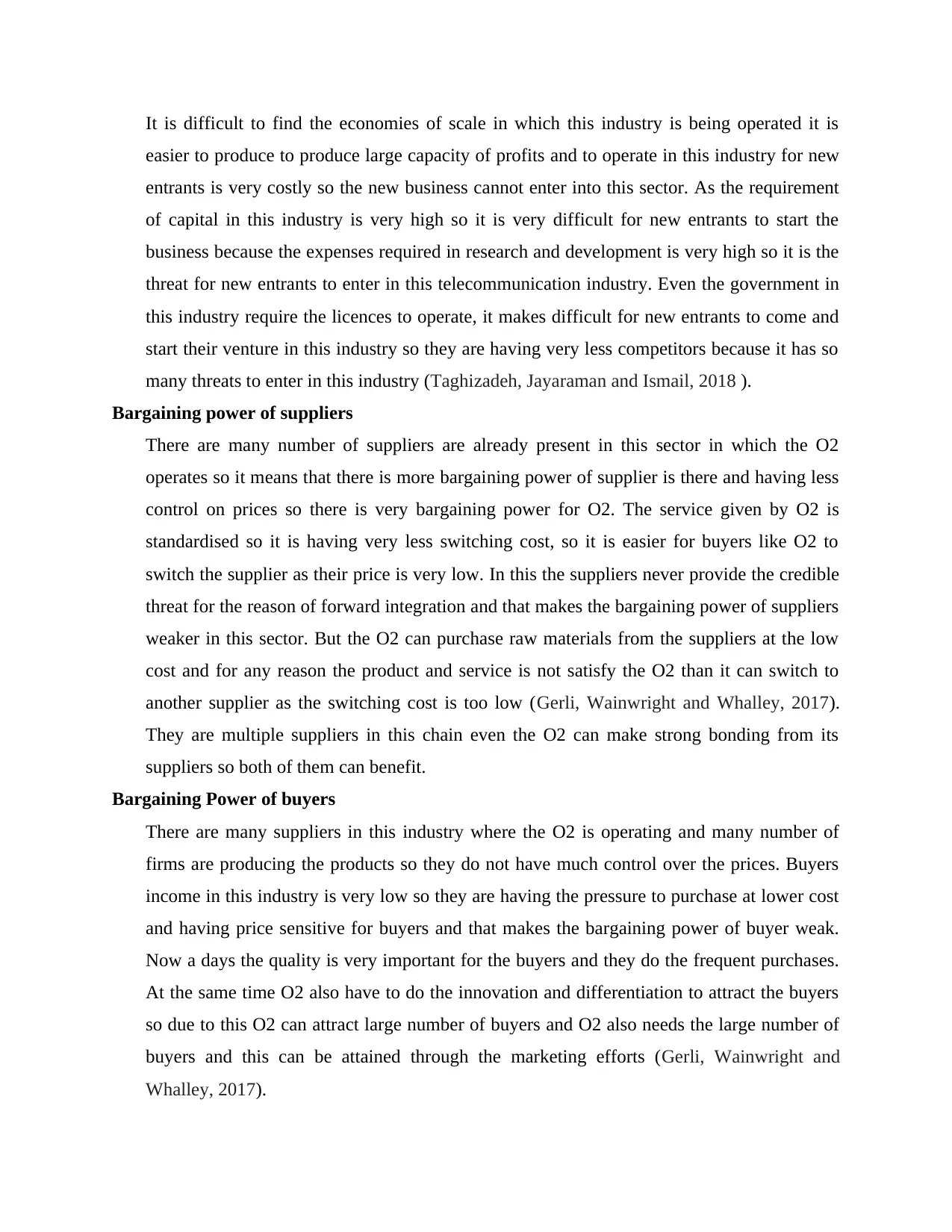
It is difficult to find the economies of scale in which this industry is being operated it is
easier to produce to produce large capacity of profits and to operate in this industry for new
entrants is very costly so the new business cannot enter into this sector. As the requirement
of capital in this industry is very high so it is very difficult for new entrants to start the
business because the expenses required in research and development is very high so it is the
threat for new entrants to enter in this telecommunication industry. Even the government in
this industry require the licences to operate, it makes difficult for new entrants to come and
start their venture in this industry so they are having very less competitors because it has so
many threats to enter in this industry (Taghizadeh, Jayaraman and Ismail, 2018 ).
Bargaining power of suppliers
There are many number of suppliers are already present in this sector in which the O2
operates so it means that there is more bargaining power of supplier is there and having less
control on prices so there is very bargaining power for O2. The service given by O2 is
standardised so it is having very less switching cost, so it is easier for buyers like O2 to
switch the supplier as their price is very low. In this the suppliers never provide the credible
threat for the reason of forward integration and that makes the bargaining power of suppliers
weaker in this sector. But the O2 can purchase raw materials from the suppliers at the low
cost and for any reason the product and service is not satisfy the O2 than it can switch to
another supplier as the switching cost is too low (Gerli, Wainwright and Whalley, 2017).
They are multiple suppliers in this chain even the O2 can make strong bonding from its
suppliers so both of them can benefit.
Bargaining Power of buyers
There are many suppliers in this industry where the O2 is operating and many number of
firms are producing the products so they do not have much control over the prices. Buyers
income in this industry is very low so they are having the pressure to purchase at lower cost
and having price sensitive for buyers and that makes the bargaining power of buyer weak.
Now a days the quality is very important for the buyers and they do the frequent purchases.
At the same time O2 also have to do the innovation and differentiation to attract the buyers
so due to this O2 can attract large number of buyers and O2 also needs the large number of
buyers and this can be attained through the marketing efforts (Gerli, Wainwright and
Whalley, 2017).
easier to produce to produce large capacity of profits and to operate in this industry for new
entrants is very costly so the new business cannot enter into this sector. As the requirement
of capital in this industry is very high so it is very difficult for new entrants to start the
business because the expenses required in research and development is very high so it is the
threat for new entrants to enter in this telecommunication industry. Even the government in
this industry require the licences to operate, it makes difficult for new entrants to come and
start their venture in this industry so they are having very less competitors because it has so
many threats to enter in this industry (Taghizadeh, Jayaraman and Ismail, 2018 ).
Bargaining power of suppliers
There are many number of suppliers are already present in this sector in which the O2
operates so it means that there is more bargaining power of supplier is there and having less
control on prices so there is very bargaining power for O2. The service given by O2 is
standardised so it is having very less switching cost, so it is easier for buyers like O2 to
switch the supplier as their price is very low. In this the suppliers never provide the credible
threat for the reason of forward integration and that makes the bargaining power of suppliers
weaker in this sector. But the O2 can purchase raw materials from the suppliers at the low
cost and for any reason the product and service is not satisfy the O2 than it can switch to
another supplier as the switching cost is too low (Gerli, Wainwright and Whalley, 2017).
They are multiple suppliers in this chain even the O2 can make strong bonding from its
suppliers so both of them can benefit.
Bargaining Power of buyers
There are many suppliers in this industry where the O2 is operating and many number of
firms are producing the products so they do not have much control over the prices. Buyers
income in this industry is very low so they are having the pressure to purchase at lower cost
and having price sensitive for buyers and that makes the bargaining power of buyer weak.
Now a days the quality is very important for the buyers and they do the frequent purchases.
At the same time O2 also have to do the innovation and differentiation to attract the buyers
so due to this O2 can attract large number of buyers and O2 also needs the large number of
buyers and this can be attained through the marketing efforts (Gerli, Wainwright and
Whalley, 2017).
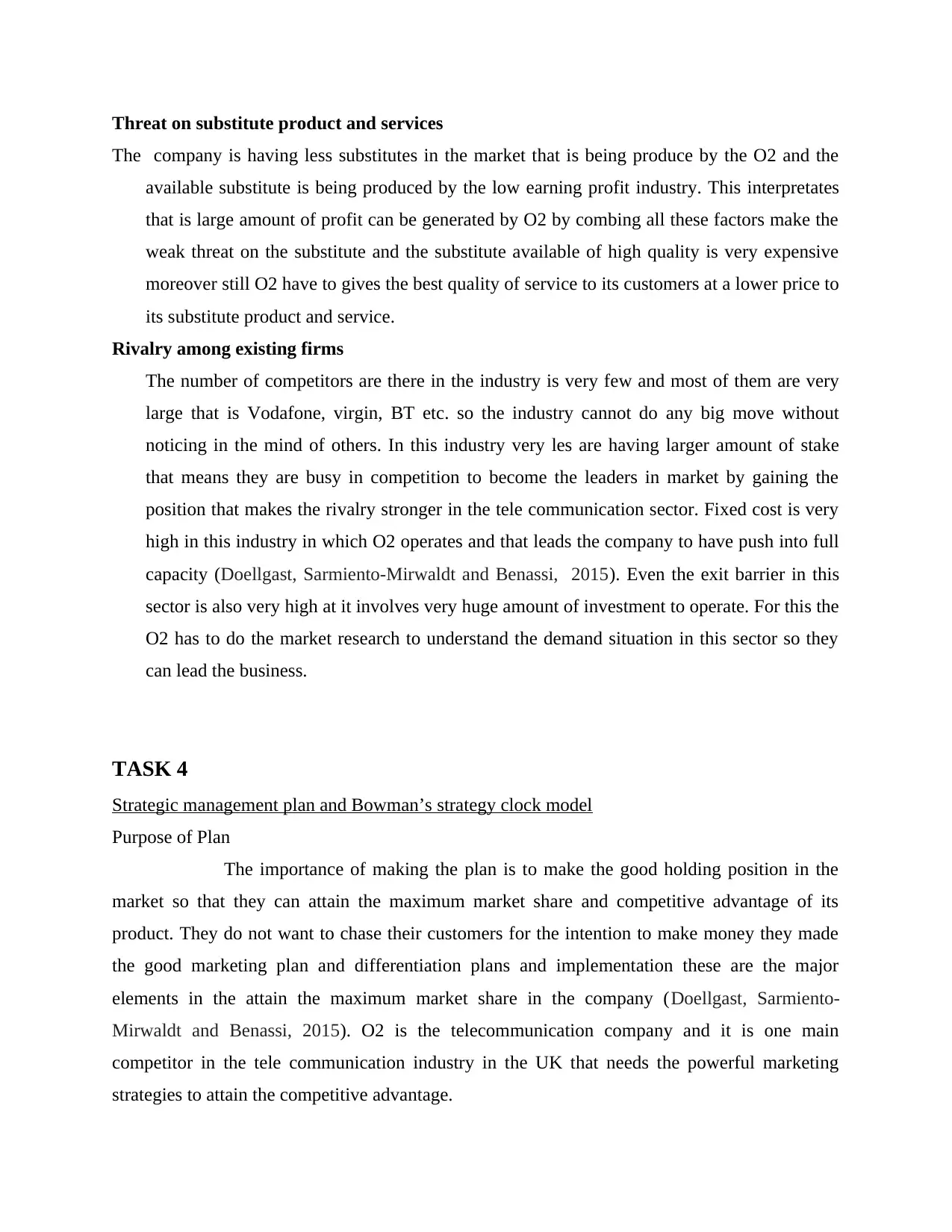
Threat on substitute product and services
The company is having less substitutes in the market that is being produce by the O2 and the
available substitute is being produced by the low earning profit industry. This interpretates
that is large amount of profit can be generated by O2 by combing all these factors make the
weak threat on the substitute and the substitute available of high quality is very expensive
moreover still O2 have to gives the best quality of service to its customers at a lower price to
its substitute product and service.
Rivalry among existing firms
The number of competitors are there in the industry is very few and most of them are very
large that is Vodafone, virgin, BT etc. so the industry cannot do any big move without
noticing in the mind of others. In this industry very les are having larger amount of stake
that means they are busy in competition to become the leaders in market by gaining the
position that makes the rivalry stronger in the tele communication sector. Fixed cost is very
high in this industry in which O2 operates and that leads the company to have push into full
capacity (Doellgast, Sarmiento-Mirwaldt and Benassi, 2015). Even the exit barrier in this
sector is also very high at it involves very huge amount of investment to operate. For this the
O2 has to do the market research to understand the demand situation in this sector so they
can lead the business.
TASK 4
Strategic management plan and Bowman’s strategy clock model
Purpose of Plan
The importance of making the plan is to make the good holding position in the
market so that they can attain the maximum market share and competitive advantage of its
product. They do not want to chase their customers for the intention to make money they made
the good marketing plan and differentiation plans and implementation these are the major
elements in the attain the maximum market share in the company (Doellgast, Sarmiento-
Mirwaldt and Benassi, 2015). O2 is the telecommunication company and it is one main
competitor in the tele communication industry in the UK that needs the powerful marketing
strategies to attain the competitive advantage.
The company is having less substitutes in the market that is being produce by the O2 and the
available substitute is being produced by the low earning profit industry. This interpretates
that is large amount of profit can be generated by O2 by combing all these factors make the
weak threat on the substitute and the substitute available of high quality is very expensive
moreover still O2 have to gives the best quality of service to its customers at a lower price to
its substitute product and service.
Rivalry among existing firms
The number of competitors are there in the industry is very few and most of them are very
large that is Vodafone, virgin, BT etc. so the industry cannot do any big move without
noticing in the mind of others. In this industry very les are having larger amount of stake
that means they are busy in competition to become the leaders in market by gaining the
position that makes the rivalry stronger in the tele communication sector. Fixed cost is very
high in this industry in which O2 operates and that leads the company to have push into full
capacity (Doellgast, Sarmiento-Mirwaldt and Benassi, 2015). Even the exit barrier in this
sector is also very high at it involves very huge amount of investment to operate. For this the
O2 has to do the market research to understand the demand situation in this sector so they
can lead the business.
TASK 4
Strategic management plan and Bowman’s strategy clock model
Purpose of Plan
The importance of making the plan is to make the good holding position in the
market so that they can attain the maximum market share and competitive advantage of its
product. They do not want to chase their customers for the intention to make money they made
the good marketing plan and differentiation plans and implementation these are the major
elements in the attain the maximum market share in the company (Doellgast, Sarmiento-
Mirwaldt and Benassi, 2015). O2 is the telecommunication company and it is one main
competitor in the tele communication industry in the UK that needs the powerful marketing
strategies to attain the competitive advantage.
Secure Best Marks with AI Grader
Need help grading? Try our AI Grader for instant feedback on your assignments.
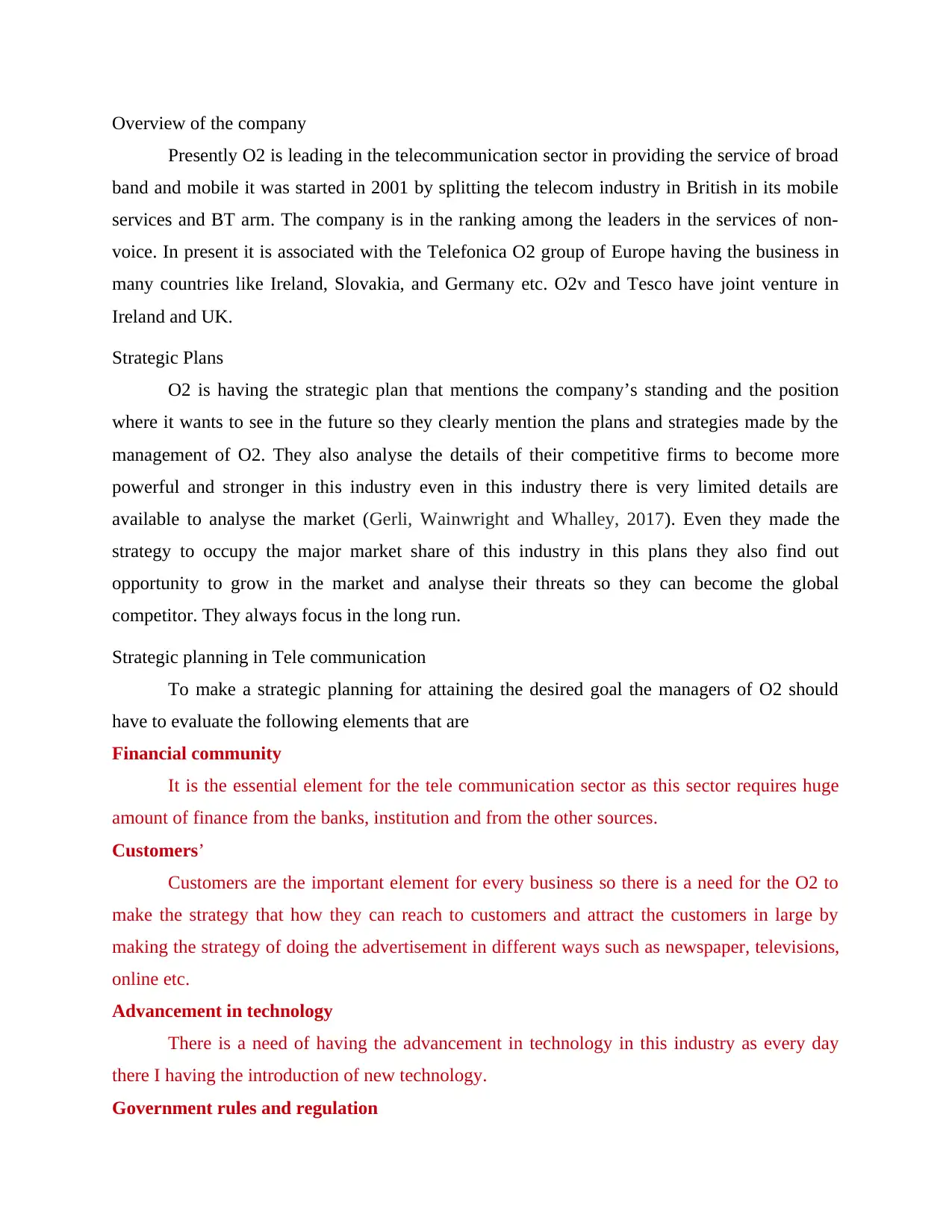
Overview of the company
Presently O2 is leading in the telecommunication sector in providing the service of broad
band and mobile it was started in 2001 by splitting the telecom industry in British in its mobile
services and BT arm. The company is in the ranking among the leaders in the services of non-
voice. In present it is associated with the Telefonica O2 group of Europe having the business in
many countries like Ireland, Slovakia, and Germany etc. O2v and Tesco have joint venture in
Ireland and UK.
Strategic Plans
O2 is having the strategic plan that mentions the company’s standing and the position
where it wants to see in the future so they clearly mention the plans and strategies made by the
management of O2. They also analyse the details of their competitive firms to become more
powerful and stronger in this industry even in this industry there is very limited details are
available to analyse the market (Gerli, Wainwright and Whalley, 2017). Even they made the
strategy to occupy the major market share of this industry in this plans they also find out
opportunity to grow in the market and analyse their threats so they can become the global
competitor. They always focus in the long run.
Strategic planning in Tele communication
To make a strategic planning for attaining the desired goal the managers of O2 should
have to evaluate the following elements that are
Financial community
It is the essential element for the tele communication sector as this sector requires huge
amount of finance from the banks, institution and from the other sources.
Customers’
Customers are the important element for every business so there is a need for the O2 to
make the strategy that how they can reach to customers and attract the customers in large by
making the strategy of doing the advertisement in different ways such as newspaper, televisions,
online etc.
Advancement in technology
There is a need of having the advancement in technology in this industry as every day
there I having the introduction of new technology.
Government rules and regulation
Presently O2 is leading in the telecommunication sector in providing the service of broad
band and mobile it was started in 2001 by splitting the telecom industry in British in its mobile
services and BT arm. The company is in the ranking among the leaders in the services of non-
voice. In present it is associated with the Telefonica O2 group of Europe having the business in
many countries like Ireland, Slovakia, and Germany etc. O2v and Tesco have joint venture in
Ireland and UK.
Strategic Plans
O2 is having the strategic plan that mentions the company’s standing and the position
where it wants to see in the future so they clearly mention the plans and strategies made by the
management of O2. They also analyse the details of their competitive firms to become more
powerful and stronger in this industry even in this industry there is very limited details are
available to analyse the market (Gerli, Wainwright and Whalley, 2017). Even they made the
strategy to occupy the major market share of this industry in this plans they also find out
opportunity to grow in the market and analyse their threats so they can become the global
competitor. They always focus in the long run.
Strategic planning in Tele communication
To make a strategic planning for attaining the desired goal the managers of O2 should
have to evaluate the following elements that are
Financial community
It is the essential element for the tele communication sector as this sector requires huge
amount of finance from the banks, institution and from the other sources.
Customers’
Customers are the important element for every business so there is a need for the O2 to
make the strategy that how they can reach to customers and attract the customers in large by
making the strategy of doing the advertisement in different ways such as newspaper, televisions,
online etc.
Advancement in technology
There is a need of having the advancement in technology in this industry as every day
there I having the introduction of new technology.
Government rules and regulation
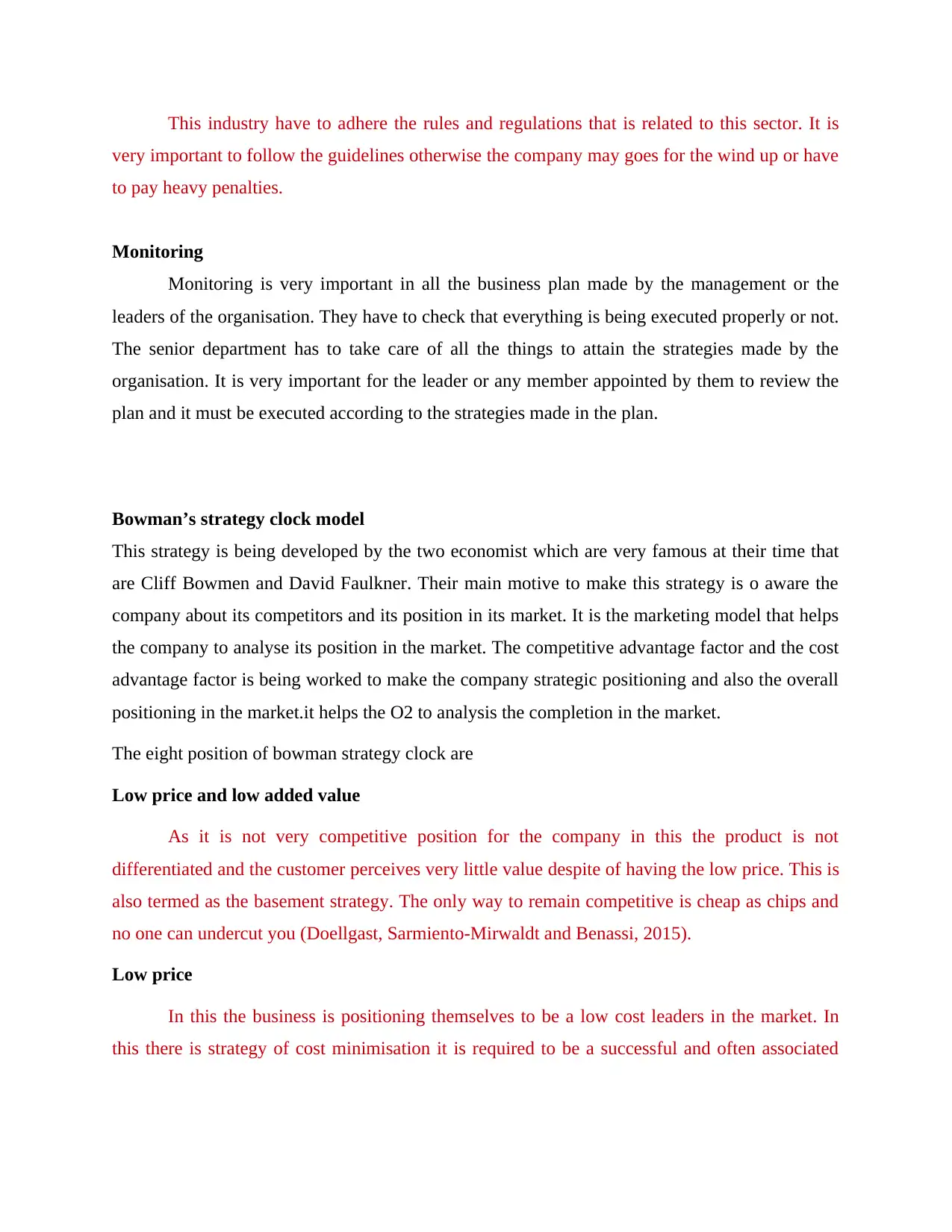
This industry have to adhere the rules and regulations that is related to this sector. It is
very important to follow the guidelines otherwise the company may goes for the wind up or have
to pay heavy penalties.
Monitoring
Monitoring is very important in all the business plan made by the management or the
leaders of the organisation. They have to check that everything is being executed properly or not.
The senior department has to take care of all the things to attain the strategies made by the
organisation. It is very important for the leader or any member appointed by them to review the
plan and it must be executed according to the strategies made in the plan.
Bowman’s strategy clock model
This strategy is being developed by the two economist which are very famous at their time that
are Cliff Bowmen and David Faulkner. Their main motive to make this strategy is o aware the
company about its competitors and its position in its market. It is the marketing model that helps
the company to analyse its position in the market. The competitive advantage factor and the cost
advantage factor is being worked to make the company strategic positioning and also the overall
positioning in the market.it helps the O2 to analysis the completion in the market.
The eight position of bowman strategy clock are
Low price and low added value
As it is not very competitive position for the company in this the product is not
differentiated and the customer perceives very little value despite of having the low price. This is
also termed as the basement strategy. The only way to remain competitive is cheap as chips and
no one can undercut you (Doellgast, Sarmiento-Mirwaldt and Benassi, 2015).
Low price
In this the business is positioning themselves to be a low cost leaders in the market. In
this there is strategy of cost minimisation it is required to be a successful and often associated
very important to follow the guidelines otherwise the company may goes for the wind up or have
to pay heavy penalties.
Monitoring
Monitoring is very important in all the business plan made by the management or the
leaders of the organisation. They have to check that everything is being executed properly or not.
The senior department has to take care of all the things to attain the strategies made by the
organisation. It is very important for the leader or any member appointed by them to review the
plan and it must be executed according to the strategies made in the plan.
Bowman’s strategy clock model
This strategy is being developed by the two economist which are very famous at their time that
are Cliff Bowmen and David Faulkner. Their main motive to make this strategy is o aware the
company about its competitors and its position in its market. It is the marketing model that helps
the company to analyse its position in the market. The competitive advantage factor and the cost
advantage factor is being worked to make the company strategic positioning and also the overall
positioning in the market.it helps the O2 to analysis the completion in the market.
The eight position of bowman strategy clock are
Low price and low added value
As it is not very competitive position for the company in this the product is not
differentiated and the customer perceives very little value despite of having the low price. This is
also termed as the basement strategy. The only way to remain competitive is cheap as chips and
no one can undercut you (Doellgast, Sarmiento-Mirwaldt and Benassi, 2015).
Low price
In this the business is positioning themselves to be a low cost leaders in the market. In
this there is strategy of cost minimisation it is required to be a successful and often associated
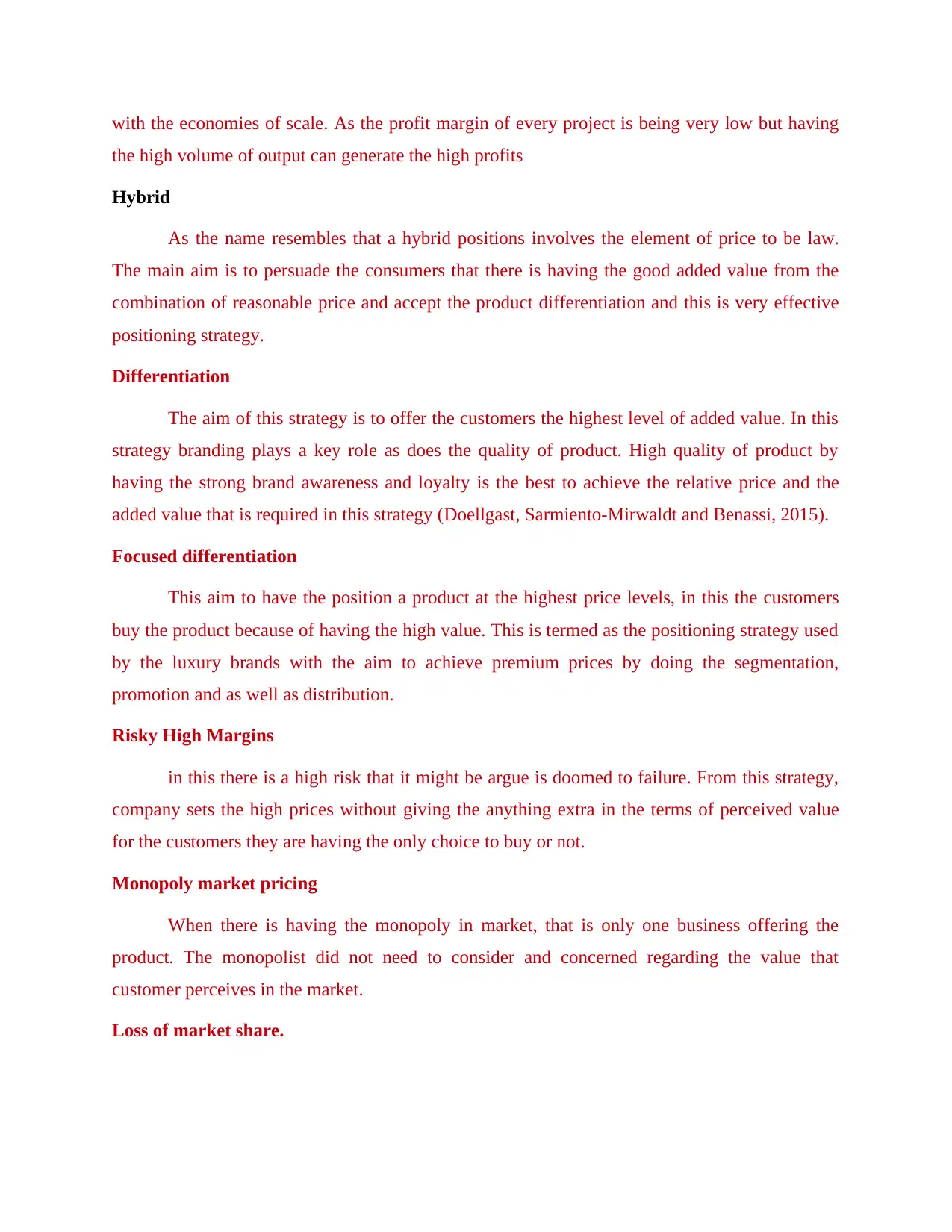
with the economies of scale. As the profit margin of every project is being very low but having
the high volume of output can generate the high profits
Hybrid
As the name resembles that a hybrid positions involves the element of price to be law.
The main aim is to persuade the consumers that there is having the good added value from the
combination of reasonable price and accept the product differentiation and this is very effective
positioning strategy.
Differentiation
The aim of this strategy is to offer the customers the highest level of added value. In this
strategy branding plays a key role as does the quality of product. High quality of product by
having the strong brand awareness and loyalty is the best to achieve the relative price and the
added value that is required in this strategy (Doellgast, Sarmiento-Mirwaldt and Benassi, 2015).
Focused differentiation
This aim to have the position a product at the highest price levels, in this the customers
buy the product because of having the high value. This is termed as the positioning strategy used
by the luxury brands with the aim to achieve premium prices by doing the segmentation,
promotion and as well as distribution.
Risky High Margins
in this there is a high risk that it might be argue is doomed to failure. From this strategy,
company sets the high prices without giving the anything extra in the terms of perceived value
for the customers they are having the only choice to buy or not.
Monopoly market pricing
When there is having the monopoly in market, that is only one business offering the
product. The monopolist did not need to consider and concerned regarding the value that
customer perceives in the market.
Loss of market share.
the high volume of output can generate the high profits
Hybrid
As the name resembles that a hybrid positions involves the element of price to be law.
The main aim is to persuade the consumers that there is having the good added value from the
combination of reasonable price and accept the product differentiation and this is very effective
positioning strategy.
Differentiation
The aim of this strategy is to offer the customers the highest level of added value. In this
strategy branding plays a key role as does the quality of product. High quality of product by
having the strong brand awareness and loyalty is the best to achieve the relative price and the
added value that is required in this strategy (Doellgast, Sarmiento-Mirwaldt and Benassi, 2015).
Focused differentiation
This aim to have the position a product at the highest price levels, in this the customers
buy the product because of having the high value. This is termed as the positioning strategy used
by the luxury brands with the aim to achieve premium prices by doing the segmentation,
promotion and as well as distribution.
Risky High Margins
in this there is a high risk that it might be argue is doomed to failure. From this strategy,
company sets the high prices without giving the anything extra in the terms of perceived value
for the customers they are having the only choice to buy or not.
Monopoly market pricing
When there is having the monopoly in market, that is only one business offering the
product. The monopolist did not need to consider and concerned regarding the value that
customer perceives in the market.
Loss of market share.
Paraphrase This Document
Need a fresh take? Get an instant paraphrase of this document with our AI Paraphraser
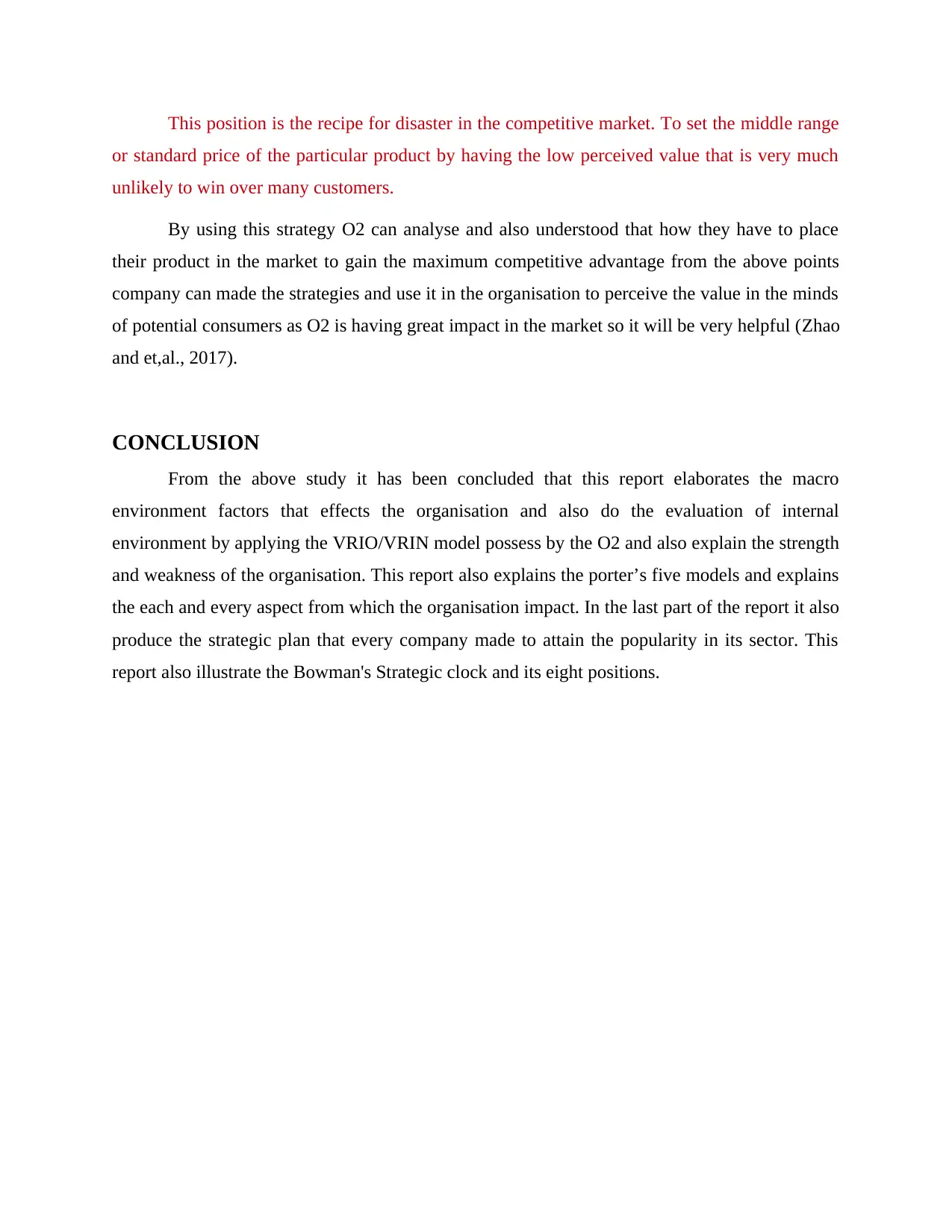
This position is the recipe for disaster in the competitive market. To set the middle range
or standard price of the particular product by having the low perceived value that is very much
unlikely to win over many customers.
By using this strategy O2 can analyse and also understood that how they have to place
their product in the market to gain the maximum competitive advantage from the above points
company can made the strategies and use it in the organisation to perceive the value in the minds
of potential consumers as O2 is having great impact in the market so it will be very helpful (Zhao
and et,al., 2017).
CONCLUSION
From the above study it has been concluded that this report elaborates the macro
environment factors that effects the organisation and also do the evaluation of internal
environment by applying the VRIO/VRIN model possess by the O2 and also explain the strength
and weakness of the organisation. This report also explains the porter’s five models and explains
the each and every aspect from which the organisation impact. In the last part of the report it also
produce the strategic plan that every company made to attain the popularity in its sector. This
report also illustrate the Bowman's Strategic clock and its eight positions.
or standard price of the particular product by having the low perceived value that is very much
unlikely to win over many customers.
By using this strategy O2 can analyse and also understood that how they have to place
their product in the market to gain the maximum competitive advantage from the above points
company can made the strategies and use it in the organisation to perceive the value in the minds
of potential consumers as O2 is having great impact in the market so it will be very helpful (Zhao
and et,al., 2017).
CONCLUSION
From the above study it has been concluded that this report elaborates the macro
environment factors that effects the organisation and also do the evaluation of internal
environment by applying the VRIO/VRIN model possess by the O2 and also explain the strength
and weakness of the organisation. This report also explains the porter’s five models and explains
the each and every aspect from which the organisation impact. In the last part of the report it also
produce the strategic plan that every company made to attain the popularity in its sector. This
report also illustrate the Bowman's Strategic clock and its eight positions.

REFERENCES
Books and Journals
Cooke, P., 2015. Computing and communications in the UK and France: innovation, regulation
and spatial dynamics-an introduction. Towards Global Localization (Routledge Library
Editions: Economic Geography). p.1.
Doellgast, V., Sarmiento-Mirwaldt, K. and Benassi, C., 2015. Union campaigns to organize
across production networks in the European telecommunications industry: Lessons from
the UK, Italy, Sweden, and Poland. The Outsourcing Challenge: Organizing Workers
Across Fragmented Production Networks. pp.177-98.
Gerli, P., Wainwright, D. and Whalley, J., 2017. Infrastructure investment on the margins of the
market: The role of niche infrastructure providers in the UK. Telecommunications
Policy. 41(9), pp.743-756.
Parcu, P. L. and Silvestri, V., 2017. Lessons from the postal sector to telecommunications and
vice versa. In The Changing Postal and Delivery Sector (pp. 17-33). Springer, Cham.
Roberts, J., 2018. Multinational business service firms: development of multinational
organization structures in the UK business service sector. Routledge.
Taghizadeh, S. K., Jayaraman, K. S. and Ismail, I., 2018. Innovation value chain as predictors for
innovation strategy in Malaysian telecommunication industry. Management. 12. pp.4-2.
Workneh, T. W., 2016. Chinese multinationals in the Ethiopian telecommunications
sector. Communication, Culture & Critique. 9(1). pp.126-147.
Yu, J., and et.al., 2017. Related yet diverging sectoral systems: telecommunications equipment
and semiconductors in China. Industry and Innovation. 24(2). pp.190-212.
Zhao, Z. Y., and et,al., 2017. Agglomeration and competitive position of contractors in the
international construction sector. Journal of construction engineering and
management. 143(6). p.04017004.
Online
PESTLE Analysis of the Telecommunication Industry. 2019. [Online]. Availaible
through<https://pestleanalysis.com/pestle-analysis-of-the-telecommunication-industry/ >
Books and Journals
Cooke, P., 2015. Computing and communications in the UK and France: innovation, regulation
and spatial dynamics-an introduction. Towards Global Localization (Routledge Library
Editions: Economic Geography). p.1.
Doellgast, V., Sarmiento-Mirwaldt, K. and Benassi, C., 2015. Union campaigns to organize
across production networks in the European telecommunications industry: Lessons from
the UK, Italy, Sweden, and Poland. The Outsourcing Challenge: Organizing Workers
Across Fragmented Production Networks. pp.177-98.
Gerli, P., Wainwright, D. and Whalley, J., 2017. Infrastructure investment on the margins of the
market: The role of niche infrastructure providers in the UK. Telecommunications
Policy. 41(9), pp.743-756.
Parcu, P. L. and Silvestri, V., 2017. Lessons from the postal sector to telecommunications and
vice versa. In The Changing Postal and Delivery Sector (pp. 17-33). Springer, Cham.
Roberts, J., 2018. Multinational business service firms: development of multinational
organization structures in the UK business service sector. Routledge.
Taghizadeh, S. K., Jayaraman, K. S. and Ismail, I., 2018. Innovation value chain as predictors for
innovation strategy in Malaysian telecommunication industry. Management. 12. pp.4-2.
Workneh, T. W., 2016. Chinese multinationals in the Ethiopian telecommunications
sector. Communication, Culture & Critique. 9(1). pp.126-147.
Yu, J., and et.al., 2017. Related yet diverging sectoral systems: telecommunications equipment
and semiconductors in China. Industry and Innovation. 24(2). pp.190-212.
Zhao, Z. Y., and et,al., 2017. Agglomeration and competitive position of contractors in the
international construction sector. Journal of construction engineering and
management. 143(6). p.04017004.
Online
PESTLE Analysis of the Telecommunication Industry. 2019. [Online]. Availaible
through<https://pestleanalysis.com/pestle-analysis-of-the-telecommunication-industry/ >
1 out of 15
Related Documents
Your All-in-One AI-Powered Toolkit for Academic Success.
+13062052269
info@desklib.com
Available 24*7 on WhatsApp / Email
![[object Object]](/_next/static/media/star-bottom.7253800d.svg)
Unlock your academic potential
© 2024 | Zucol Services PVT LTD | All rights reserved.





